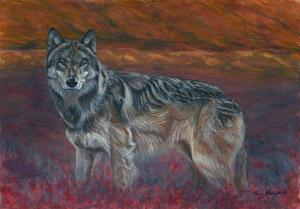Sale on canvas prints! Use code ABCXYZ at checkout for a special discount!

This is the journal of Wyakin, the Gray Wolf. Follow along as he reveals his journey…
“The arrival of spring has brought great excitement to my pack. The pups have boundless energy. Not yet old enough to recognize the dangers of this world, they play without fear. The mule deer and elk fawns are aplenty this time of year, so hopefully we’ll find nourishment.
I’ve been remodeling our den. The winter was tough on it. It’s an old den, maybe hundreds of years old. I’m pretty sure it belonged to a bear prior to us. It’s no wonder it’s been around so long considering its elevation and proximity to water. This morning, I smelled a dead salmon along the river not far from our den. Easy finds are always helpful...”
Wyakin’s Ecological Impact: Wyakin helps control and maintain the elk population. During the winter, elk feed on seedlings and saplings of deciduous trees. By reducing the number of elk, more trees, such as the American Elm, can grow. This, in turn, creates more shade, which is required by the fish in the streams. More fish provides more food for beavers, which, in turn, provide the lush environments for ducks, frogs, turtles, insects, snakes and fish through their creation of dams. The branches and sticks brought in by beavers provide shelter, both above and below the water’s surface. Snakes and turtles can warm their coldblooded bodies in the sun, and fish can thrive in the deep and shallow pockets that have been created. Ducks and geese are provided the optimal environment to build nests and raise their young. And finally, since the deciduous American Elm is left to grow, all of the impacted organisms are able to contribute their vital roles to the maintenance of nitrogen cycle on which we depend.